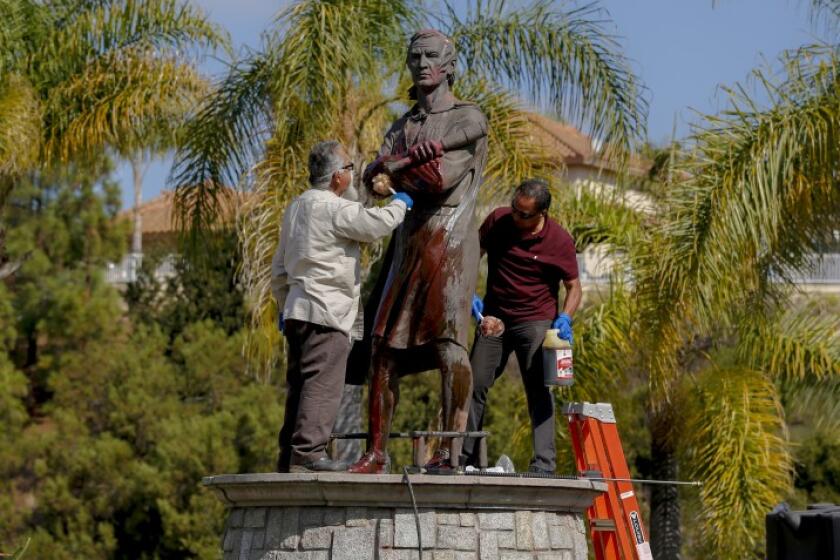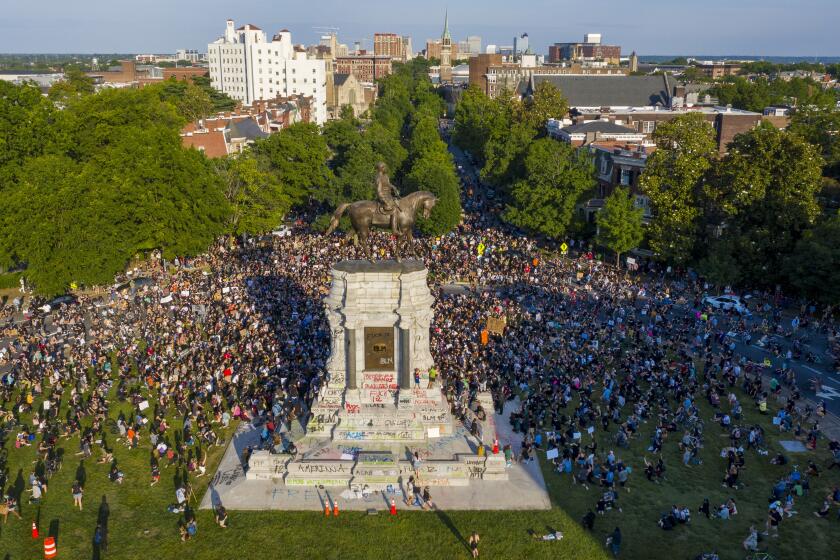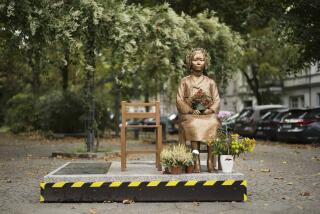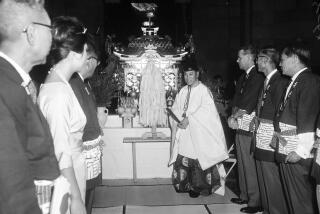Where have statues of Confederates, and other historical figures, been removed?
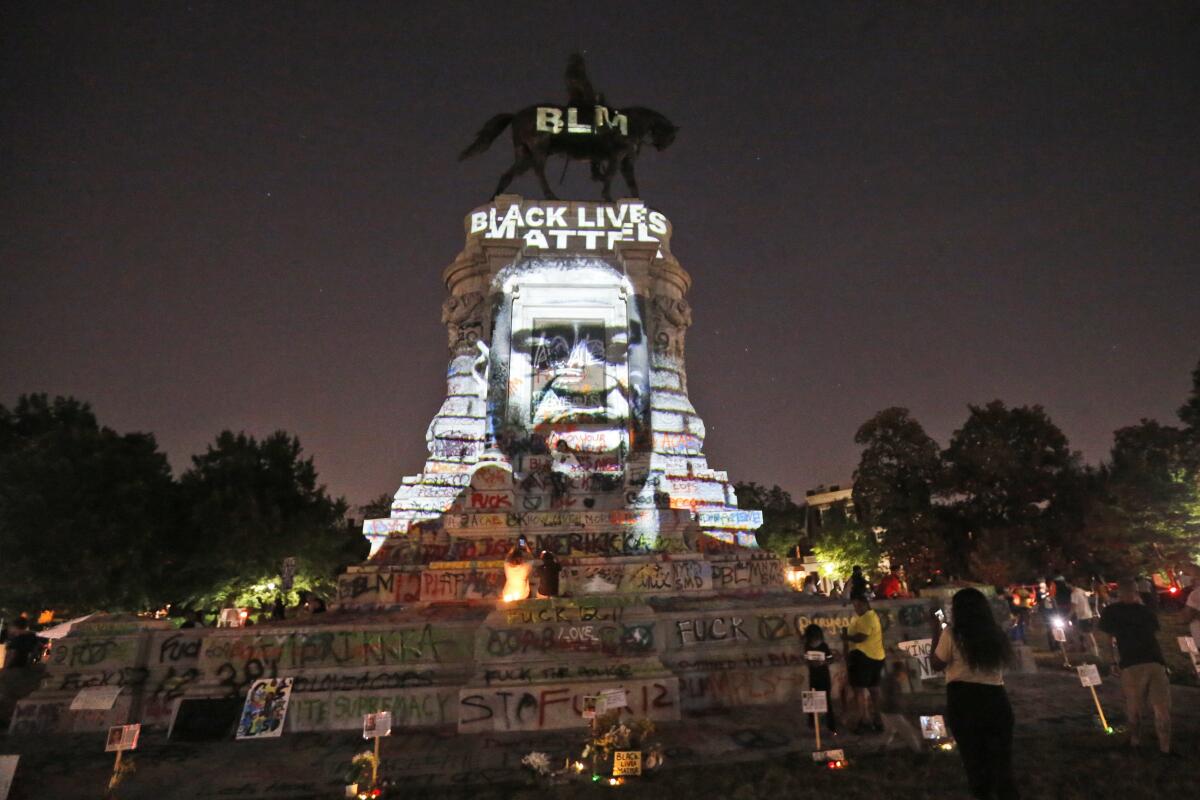
- Share via
States and municipalities across the nation are removing Confederate statues and those of other historical figures such as Christopher Columbus amid protests over systemic racism, police violence and the killing of George Floyd.
Monuments around the country have fallen in recent years amid contentious debate over whether they are proud monuments to Southern heritage or symbols of racism and slavery. Here’s a look at recent developments, state by state:
Alabama
A bronze statue of Adm. Raphael Semmes, a Confederate Navy officer, was relocated from a downtown Mobile street, where it stood for 120 years, to the History Museum of Mobile on June 5.
“I have no doubt that moving the statue from public display was the right thing to do for our community going forward. The values represented by this monument a century ago are not the values of Mobile in 2020,” Mayor Sandy Stimpson said.
Atty. Gen. Steve Marshall sent a June 5 letter to the mayor after the statue’s removal saying the city could be subject to a $25,000 fine for permanently moving the statue, an action that would violate a state law protecting monuments over 40 years old.
Marshall’s office also threatened legal action against the city of Birmingham, about 250 miles north of Mobile, for removing a “Soldiers and Sailors” Confederate monument. Birmingham Mayor Randall Woodfin said the potential $25,000 fine was worth the removal of the statue that had become a flashpoint in the majority-Black city.
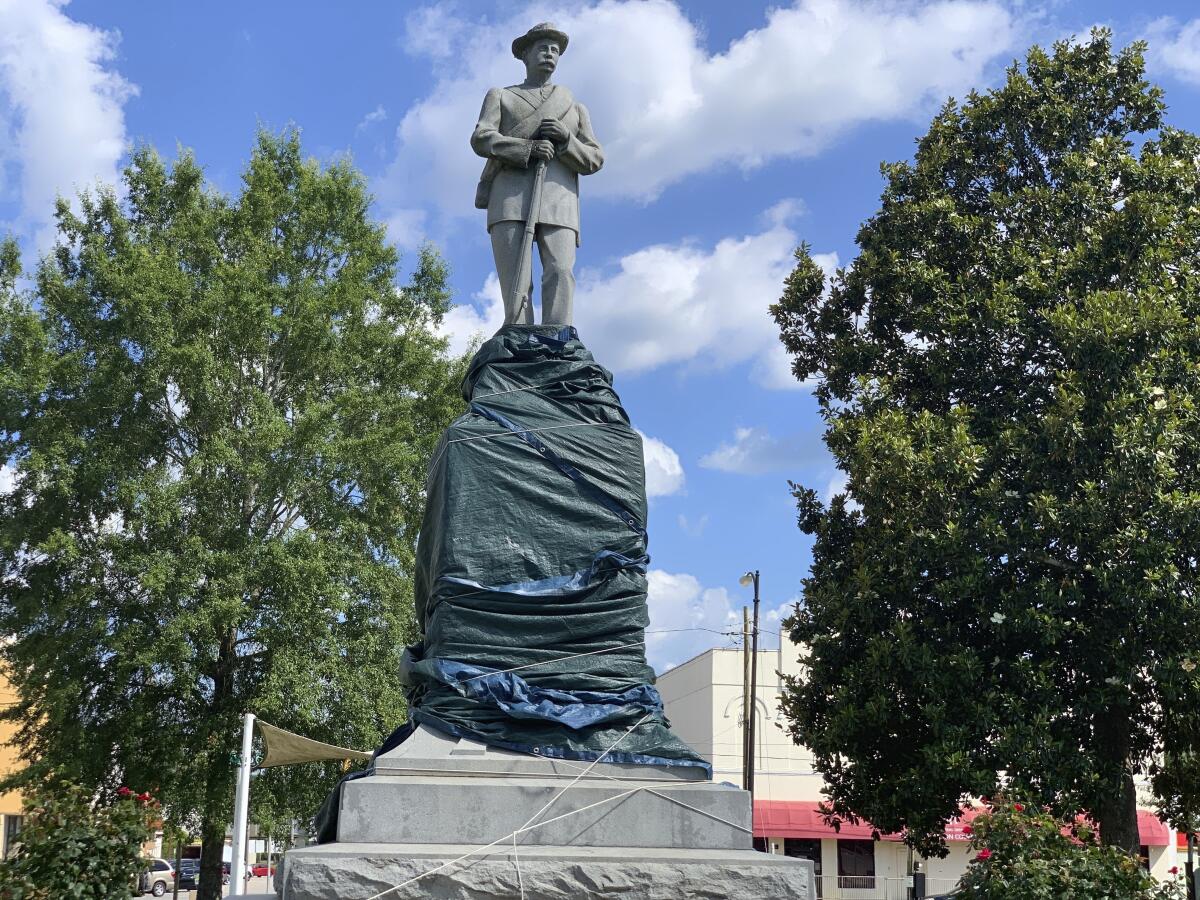
Macon County, a majority-Black county in east Alabama known as a birthplace of Black empowerment, is covering up a Confederate memorial erected more than a century ago and looking for ways to remove it permanently, a government leader said on June 9.
Workers used a tarpaulin and ropes to cover up the square base of a 111-year-old statue because it was recently spray-painted with obscenities, Macon County Commission Chairman Louis Maxwell said. Unable to do more because of high winds, crews will look at covering the statue later, he said.
The county, which is more than 80% Black, also is researching what will be needed to remove the statue from its base and relocate it elsewhere, perhaps to a nearby heritage museum, Maxwell said.
“It’s part of the history of the county whether you like it or not, and we want to preserve it,” he said.
— Associated Press
Arkansas
The city of Little Rock removed the Memorial to Company A, Capital Guards statue on June 18 from downtown MacArthur Park, Mayor Frank Scott Jr. said. The Capital Guards statue was placed at the park in 1911 during the United Confederate Veterans Reunion, he said. It honored a militia unit that formed to fight for the Confederacy.
“The Capital Guards were memorialized without concern for those in our community who have suffered grave injustices and whose ancestors were viewed as less than human so that they could be subjugated to terror and forced to provide free labor,” Scott said.
A Confederate soldier monument that has been in Bentonville’s downtown square since 1908 will be removed from a public space and relocated to a private park, the Northwest Arkansas Democrat-Gazette reported.
The Arkansas Division United Daughters of the Confederacy agreed to move the statue after conversations with community leaders.
— Associated Press
California
A statue of Christopher Columbus near San Francisco’s Coit Tower was removed the morning of June 18 and placed in storage, officials said.
The statue was removed at the direction of Mayor London Breed, and the reasoning behind it was twofold. According to the San Francisco Arts Commission, which oversees the care of the city’s civic art collection, the installation did not align with the city’s “commitment to racial justice.” At the same time, a planned protest had circulated online calling on citizens to assemble June 19 and remove the 2-ton, 12-foot-tall statue from its pedestal. Because of the risk to residents, officials said they acted proactively to remove the statue.
And sainthood may reserve a prominent space in heaven for California missionary Junipero Serra, but a statue of the 18th century Roman Catholic priest will soon no longer have a home in front of Ventura City Hall.
Ventura Mayor Matt LaVere, representatives from the Barbareño/Venureño Band of Mission Indians and Father Tom Elewaut, pastor of nearby Mission San Buenaventura, issued a joint statement on June 18 agreeing to take down the statue and have it “moved to a more appropriate non-public location.”
“I always knew that this moment, despite all the issues our people have faced, would happen,” Chief Julie Tumamait Stenslie, whose Barbareño/Venureño Band comprises Chumash members, said in a phone interview Thursday evening. “We’re constantly fighting to correct our history, and if there was ever a time to speak up, the time was now.”
Serra, born on the Spanish island of Mallorca in 1713, is a controversial figure in California, particularly among indigenous tribes. His mission system was responsible for the destruction of several tribes, often through the introduction of foreign diseases. Tribes that did survive, such as the Chumash, still suffered greatly and were often forced into building the missions.
In Chula Vista, a statue of Christopher Columbus was pulled down June 12 and placed in storage, hours before a planned protest to push for its removal.
“The statue was removed out of public safety concerns,” the city announced in a news release. “The statue was removed and stored early this morning.”
The statue’s longtime location, in the city’s Discovery Park since 1991, was the site of a protest set for 2 p.m. June 12. It was that protest that prompted the removal.
Mayor Mary Casillas Salas said she spoke with the city manager and police chief and decided to take it down preemptively to prevent it from being pulled down during the protest and possibly hurting someone.
“Our primary concern was the safety of our community,” Salas said, “and certainly we didn’t want to have anything exacerbate the tension that was being felt throughout the United States.”
— San Diego Union-Tribune staff writer Teri Figueroa and Associated Press
The removal came hours before a protest challenging the controversial figure.
Connecticut
Following instances of protesters vandalizing and tearing down Christopher Columbus statues across the country, the mayor of New London, Conn., decided to remove the city’s own monument in fears of a “copy cat crime,” NBC Connecticut reported.
Petitions supporting the statue’s removal have acquired thousands of signatures, and the monument was spray-painted prior to Mayor Michael Passero’s decision. He says he wants input from the public in deciding where the statue will go.
Columbus’ sailing expeditions led Europeans to colonize America, opening the door to centuries of exploration, conquest and settlement that included establishment of the trans-Atlantic slave trade and the killing of scores of Native Americans.
In Middletown, a statue of Columbus was temporarily removed from a park over the weekend in preparation for construction work, but officials are considering making the move permanent amid debate nationally over the explorer’s legacy.
— Times staff writer Georgia Geen
Delaware
Officials in Delaware have removed a statue of Columbus and a statue of a former Delaware leader who owned slaves.
The News Journal says that Wilmington officials on June 12 removed the Columbus statue, followed by one of Caesar Rodney, who rode 70 miles through a thunderstorm to Philadelphia in 1776 to cast the deciding vote for Delaware to join 11 other colonies in voting for a resolution to declare independence from Great Britain.
The Rodney statue was moved onto a flatbed truck to the sounds of cheers and claps.
— Associated Press
Florida
A Confederate statue that had been in a northeast Florida park for more than a century was removed in the predawn hours of June 9 ahead of a protest demanding racial equality.
The statue of a Confederate soldier sat atop a 62-foot monument in downtown Jacksonville’s Hemming Park next to City Hall until it was removed without any announcement from city officials.
Mayor Lenny Curry had avoided taking a stance on the divisive issue of honoring the Confederacy on public property, according to the Florida Times-Union.
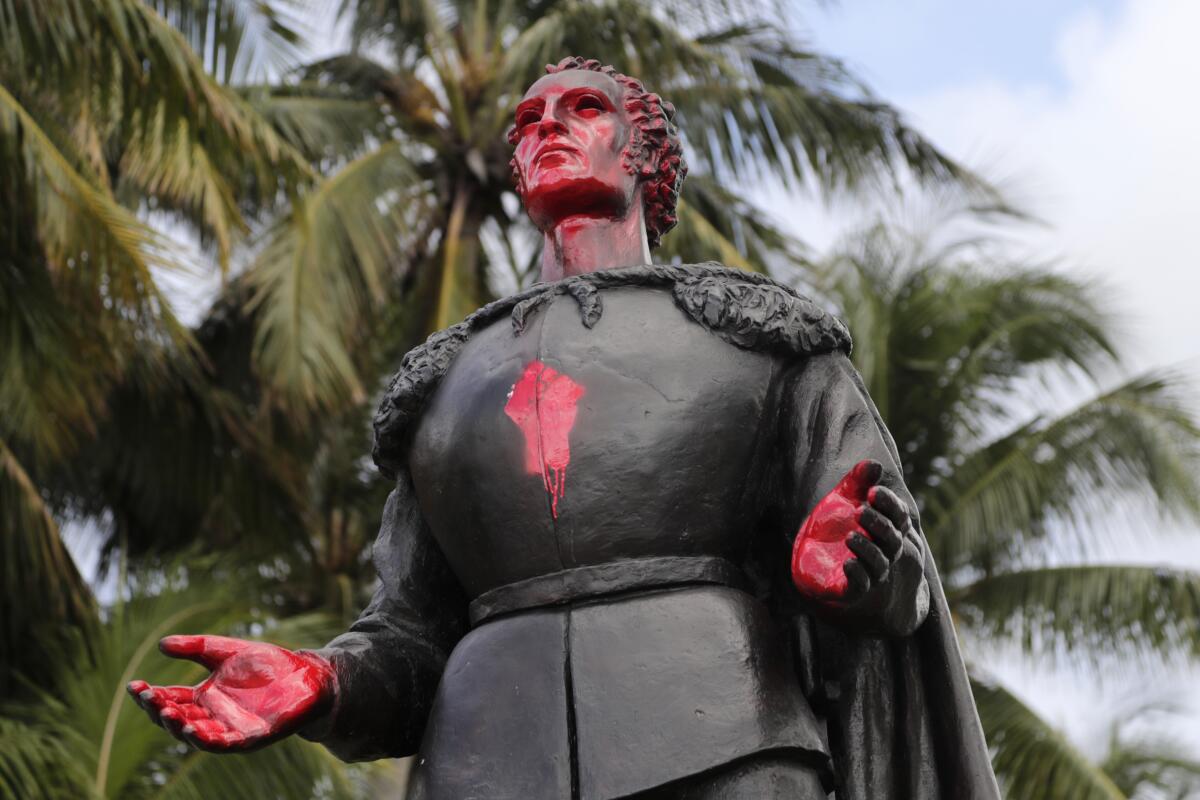
In Miami, seven people were arrested for vandalizing statues of Columbus and Juan Ponce de León in Miami, and one man was charged with smashing a patrol car with his skateboard and trying to incite a riot, the city’s police said.
Demonstrators spray-painted statues of Columbus and De León, a Spanish conquistador who landed in Florida, in Bayfront Park with the letters “George Floyd,” “BLM,” and a hammer and sickle, news outlets reported. Miami police said one man encouraged other protesters to attack a patrol car and he smashed the vehicle’s windshield with his skateboard, shattering glass on officers inside.
— Associated Press
Georgia
In Atlanta, a woman was arrested after a statue of a Confederate leader and former governor was defaced outside the state Capitol, the Atlanta Journal Constitution reported.
John Brown Gordon, in addition to being a Confederate war commander, was known as a Ku Klux Klan leader in Georgia. Demonstrators gathered daily last week urging the removal of the monument.
Separately, a judge called for the immediate relocation of a Confederate monument on June 12 in DeKalb County outside Atlanta, saying the monument had become a threat to public safety. The monument was erected in 1908 by the United Daughters of the Confederacy.
— Times staff writer Georgia Geen
Southern mayors and Virginia’s governor are striking while the iron is hot, using the unprecedented moment to get it done.
Indiana
Workers in Indianapolis on June 8 started dismantling a monument dedicated to Confederate soldiers who died at a Union prison camp in the city.
Mayor Joe Hogsett announced last week that the monument would be removed from Garfield Park. It was moved there from a cemetery in 1928 following efforts by public officials active in the Ku Klux Klan who sought to “make the monument more visible to the public,” according to a news release from Hogsett’s office.
The Indianapolis Parks Board passed a resolution in 2017 to remove the monument once funding was secured, but that never happened. Hogsett said the city was identifying a source of funding, with the expected cost ranging from $50,000 to $100,000.
The park’s resolution came after an Indianapolis man was arrested for vandalizing the memorial following a white nationalist rally in Charlottesville, Va., fueled by that city’s proposal to remove Confederate statues. A woman died during the rally.
The monument was commissioned in 1912 for Greenlawn Cemetery to commemorate Confederate prisoners of war who died at Camp Morton in Indianapolis.
— Associated Press
Kentucky
Having led the push to take down a statue of Jefferson Davis from the Kentucky Capitol, the state’s governor had a ceremonial role June 13 in its removal from the place it stood for generations.
Gov. Andy Beshear pushed the button to a rig that lifted the 15-foot marble statue off its pedestal in the ornate Capitol Rotunda. The governor tweeted a photo showing the memorial to the Confederate president being hoisted for removal.
“Today I pressed the button to bring it down,” the Democratic governor said in his tweet. “Now, every child who walks into their Capitol feels welcome. Today we took a step forward for the betterment of every single Kentuckian.”
In a quintessentially Kentucky twist, workers discovered an empty bourbon bottle in the base after the statue was hoisted. Also found was a newspaper front page.
On June 8, acting with court approval, a work crew also removed a Confederate statue from a prominent location in Kentucky’s largest city.
Work began about 6 a.m. to dismantle the John Breckenridge Castleman monument from Cherokee Triangle, Louisville Mayor Greg Fischer said. Shortly thereafter, only a bare pedestal remained. The decisive action followed a Jefferson Circuit Court ruling Friday after nearly two years of legal wrangling and vandalism.
The statue will be cleaned and stored until it can be moved, likely to Cave Hill Cemetery, where Castleman is buried, officials said.
Castleman was a Confederate soldier and later a U.S. general. He helped found Louisville’s park system. Louisville Mayor Greg Fischer’s administration has pushed to relocate the statue because of Castleman’s ties to the Confederacy and support of slavery.
The statue has been vandalized multiple times in recent years. The mayor announced his intent to move it in 2018 based on findings of a local Public Art and Monuments Advisory Committee, but legal challenges delayed his plan.
— Associated Press
Louisiana
A parish in southeastern Louisiana voted unanimously to remove a statue of a Confederate soldier in front of the courthouse
Local media report that the Iberville Parish Council voted on June 16 to move the statue, which has stood for more than a century. The Advocate reports that at the base of the statue are the words: “The principles for which they fought live eternally.”
“It shows that we’re actually moving forward finally and getting things done,” said council member Raheem Pierce. “We need to create new symbols together: white and Black, Republican and Democrat.”
In New Orleans on June 13, protesters tore down a bust of a slave owner, who left part of his fortune to the city’s schools, and threw it into the Mississippi River.
The statue of John McDonogh, a wealthy entrepreneur and slave owner who died in 1850, previously stood at Duncan Plaza, which is directly across from City Hall.
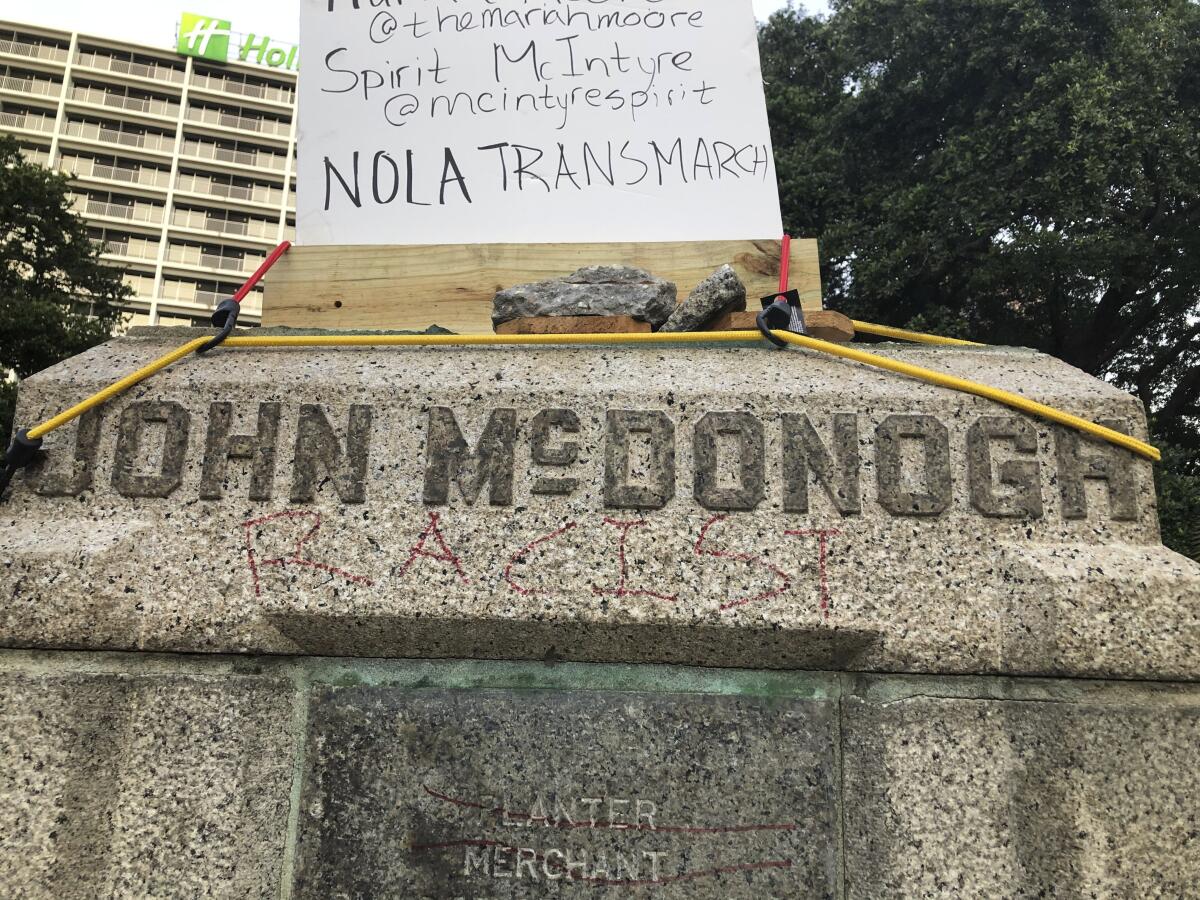
Two people who were driving the trucks transporting the bust were apprehended by police and taken to police headquarters, authorities said. Their names were not given in the statement.
— Associated Press
Massachusetts
A beheaded Columbus statue was removed June 11 from a park in Boston’s historically Italian North End.
The statue, which was found beheaded early June 10, will be placed in storage as the city reassesses its significance, Democratic Mayor Marty Walsh said. Walsh also said he was open to discussing changing the name of another landmark that has drawn protesters’ ire: Faneuil Hall — considered the “Cradle of Liberty.”
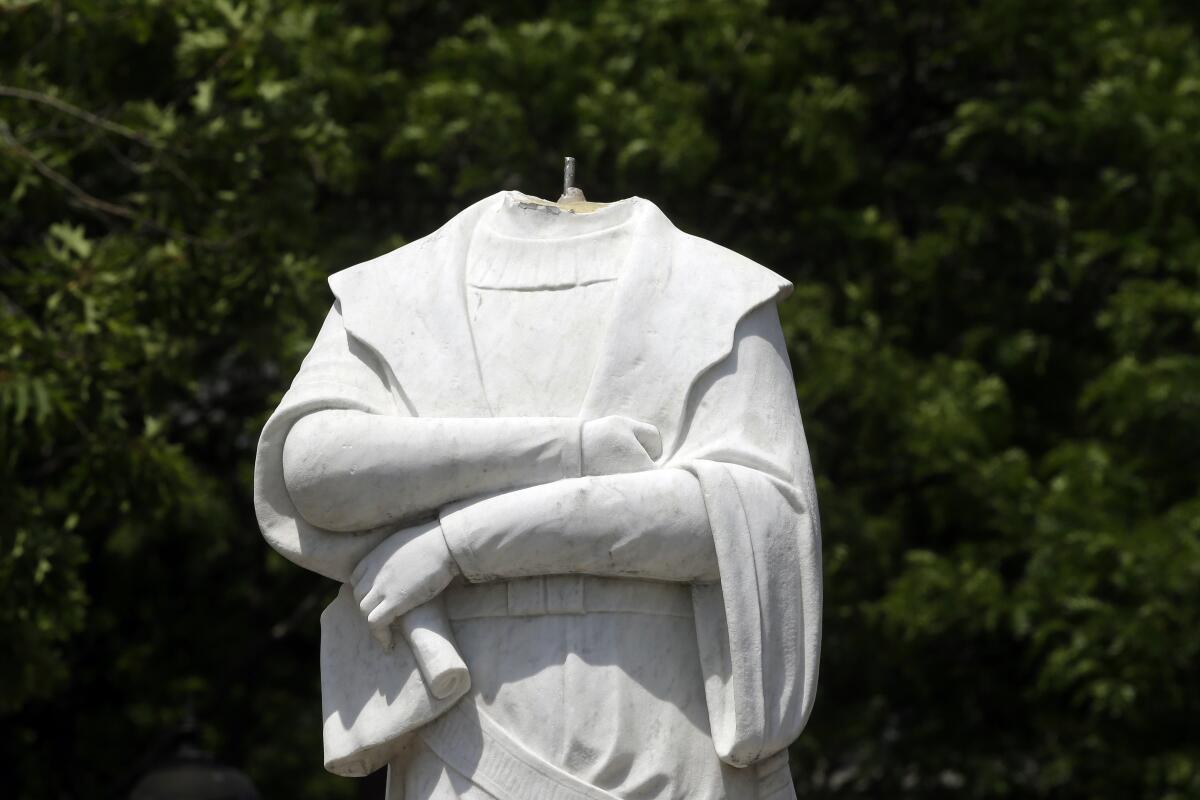
Passersby glancing at the empty granite pedestal where the towering statue once stood said they had mixed emotions.
— Associated Press
Michigan
The city of Detroit has removed a bust of Columbus from a prominent downtown area after 110 years.
The bust was placed in storage until its future can be determined, Mayor Mike Duggan told reporters on June 15.
“I’ve been bothered for a while by the fact that the statue is occupying such a place of prominence next to City Hall,” Duggan said. “But when I looked at some of the violence around the country, in particular, you’ve got people with arms gathering around a Columbus statue in Philadelphia arguing with people.”
A group of people, some carrying guns and baseball bats, spent the weekend around the statue in South Philadelphia saying they intended to protect it from vandals.
“We just don’t need this,” Duggan added. “We should have a conversation as a community as to what is the appropriate place for such a statue. But I don’t want to have that conversation ... at gunpoint or in the middle of argument.”
— Associated Press
Minnesota
Protesters in Minnesota on June 10 pulled down a 10-foot bronze statue of Columbus outside the state Capitol.
The protesters, including Dakota and Ojibwe Indians, said they consider Columbus a symbol of genocide against Native Americans. They said they had tried many times to remove it through the political process, but without success.
State Patrol troopers in helmets, who provide security in the Capitol complex, stood by at a distance but did not try to stop the protesters, who celebrated afterward with Native American singing and drumming.
— Associated Press
Mississippi
A Confederate monument will be moved from a prominent spot at the University of Mississippi to a Civil War cemetery in a secluded part of the Oxford campus.
The state college board met June 18 and approved a proposal to move the monument. No timeline was given for the move. The estimated cost of the move is $1.2 million, which will be paid with private donations, not public money, the board said.
Critics say its display near the university’s main administrative building sends a signal that Ole Miss glorifies the Confederacy and glosses over the South’s history of slavery.
A former University of Mississippi student was arrested May 30 after he spray painted “Spiritual Genocide” and left bloody handprints on the monument. He was charged with defacing public property, and the monument has already been cleaned.
— Associated Press
New Jersey
Camden, a New Jersey city near Philadelphia, took down a statue of Columbus in Farnham Park, calling it a “controversial symbol” that has “long pained residents of the community.”
Video from local news outlets showed the statue coming down the night of June 12. The city’s statement says “a plan to reexamine these outdated symbols of racial division and injustices” is overdue. The majority of Camden residents are people of color.
— Associated Press

New York
A statue being removed from New York’s capital city of slave-owning Revolutionary War Gen. Philip Schuyler could end up on display in a town bearing his name.
Schuylerville’s mayor is lobbying to take possession of the 9½-foot bronze statue after Albany Mayor Kathy Sheehan signed an executive order June 11 to remove it.
Schuyler led the Continental Army to victory at the pivotal Battle of Saratoga and later served in the U.S. Senate.
Sheehan’s order said the public display “ignored a grim aspect of his life.” She has not given a time frame for the removal of the statue outside Albany’s City Hall, but her order says it should be moved to a museum or other institution where it can be displayed with proper historical context.
— Associated Press
North Carolina
The North Carolina city of Salisbury has approved a measure that would remove an 111-year-old Confederate monument there. The Charlotte Observer reported on June 17 that the statue in Salisbury depicts a Greek goddess holding a dying Confederate soldier.
Salisbury’s police chief has deemed the monument to be a public safety threat. It has been the site of heated protests that have seen someone fire gun shots into the air, police in riot gear use tear gas and an officer injured.
The city northeast of Charlotte approved an agreement June 16 that would pay to move the statue to a cemetery and for a new foundation at the cemetery.
In Greenville a day earlier, a county board of commissioners voted to remove a Confederate statue immediately, WITN reported.
The monument was erected at the Pitt County Courthouse in 1914 by the United Daughters of the Confederacy. Once it’s removed, it will be put in storage until it can be relocated.
A statue of former Carolina Panthers owner Jerry Richardson, who was accused in 2017 of making sexually suggestive comments to women and a racial slur directed at a Black team scout, was lifted from its pedestal outside the team’s stadium and taken away June 10.
“We were aware of the most recent conversation surrounding the Jerry Richardson statue and are concerned there may be attempts to take it down,” a team statement said. “We are moving the statue in the interest of public safety.”
The statement did not elaborate on the information that prompted the removal of the 13-foot statue, which was originally placed outside the north gate of Bank of America Stadium in 2016 as a gift from team minority partners honoring Richardson’s 80th birthday.
A team spokesman would not say if the statue was coming down for good.
The statue of a former newspaper publisher, U.S. Navy secretary and lifelong white supremacist has been taken down in Raleigh. The Raleigh News & Observer reported the statue of Josephus Daniels was removed from the city’s Nash Square.
“The time is right,” said Frank Daniels III, a former executive editor of the newspaper who watched the monument to his great-grandfather come down. “I don’t think anyone would say that it’s not the appropriate time to move the statue of Josephus to a more appropriate location.”
The monument will be put into storage, he said.
— Associated Press and Times staff writer Georgia Geen
Ohio
A statue of Christopher Columbus will be removed by the largest city that bears the explorer’s name, the Ohio capital’s mayor announced June 18.
The statue located in front of City Hall in Columbus, Ohio, will be removed immediately and placed in storage.
“For many people in our community, the statue represents patriarchy, oppression and divisiveness.” Democratic Mayor Andrew Ginther said in a release. “That does not represent our great city, and we will no longer live in the shadow of our ugly past.”
This is the second announcement this week of a monument enshrined to the explorer being removed in Columbus.
Columbus State Community College said June 16 it will be dismantling the statue of Columbus that has been displayed on its downtown campus since 1988.
“We do not seek to erase history, but to make an intentional shift in what we visibly honor and celebrate as an institution,” Columbus State Board of Trustees President Anthony Joseph said.
— Associated Press
Oklahoma
The Cherokee Nation has removed two confederate monuments from its Capitol Square that were erected nearly a century ago by the Daughters of the Confederacy.
A crane removed the monuments from the nation’s tribal headquarters in Tahlequah on June 13 as Principal Chief Chuck Hoskin, Jr. watched.
“It’s difficult to tell our story when we have non-Indian-driven monuments talking about the Confederacy, when they greet people as they come into our Cherokee Nation museum,” Hoskin said in a statement. “It was time for a change.”
The monuments included a fountain memorializing confederate soldiers and Gen. Stand Watie, dedicated in 1913, and a granite monument honoring Watie, dedicated in 1921.
The tribe notes on its website that the Civil War created division among its citizens with about one-third of the men joining the confederacy and then Principal Chief John Ross later agreeing to support the Confederacy after Union troops left a nearby fort.
— Associated Press
Readers respond to our interview with Spike Lee, Bible quotes by Ivanka Trump and columns about racism, white complicity and TV coverage of protests.
Oregon
Following protests in Portland, a statue of Thomas Jefferson was toppled outside a high school named for the former president on June 14.
The phrase “slave owner” was spray-painted across the base of the monument earlier in the evening, CBS affiliate KOIN-TV reported.
Activists tore down two pioneer statues, which Native American students said misrepresented Oregon’s history, on the University of Oregon’s campus on June 13, the Register-Guard reported.
The Pioneer Father, one of the monuments taken down, had been vandalized last year as students protested its presence on campus.
— Times staff writer Georgia Geen
South Carolina
Despite a South Carolina law protecting monuments, officials in the historic city of Charleston announced June 17 that they plan to remove a statue of slavery advocate John C. Calhoun from a downtown square.
Mayor John Tecklenburg announced he will send a resolution to the City Council to remove the statue at a news conference on the fifth anniversary of the slaying of eight black church members and their pastor in Dylann Roof’s racist attack at a downtown Charleston church.
“What a beautiful show of support from our City Council,” Tecklenburg said, adding that he was happy to see so many come together in the effort “not to erase our long and often tragic history but to begin to write a new and more equitable future.” The mayor anticipated the statue will go to a local museum or educational institution.
Columbia, S.C., the first city in the United States named for Columbus, has removed a statue of the explorer and placed it in storage for safekeeping after it was vandalized several times in a week.
Workers dismembered the statue early June 12, and by mid-morning only the feet were attached to the pedestal at Riverfront Park.
The statue will be stored until citizens, the Columbia City Council and other officials can have a comprehensive discussion about what to do next, Mayor Steve Benjamin said.
The mayor said he didn’t want the fate of the Columbus statue to be decided by protesters destroying it in the middle of the night.
— Associated Press
Texas
A statue of a Confederate soldier has been removed from a downtown Houston park, and a second Confederate statue is expected to be removed soon, officials said.
The “Spirit of the Confederacy” statue was removed late on the night of June 16 from Sam Houston Park and will be housed in the Houston Museum of African American Culture, under a plan announced last week by Mayor Sylvester Turner.
A second statue, of Confederate artillery commander Richard W. “Dick” Dowling, is also slated for removal. Initially, the Dowling statue was to be moved from Hermann Park to the Sabine Pass Battleground State Historical Site near Port Arthur.
But officials said Tuesday that the Dowling statue will instead be placed in a warehouse, at least temporarily, after leaders in Port Arthur expressed opposition, the Houston Chronicle reported.
In Houston, the left hand has been lopped off a 7-foot statue of Columbus that’s been a repeated target of vandals.
The vandalism was discovered the night of June 11 in Houston’s Bell Park. Besides the severed hand, a noose was left around the statue in what was the second attack on it in as many nights.
Red paint was found splashed on the hands and face of the statue Wednesday night. A cardboard sign was left behind saying, “Rip the hand from your oppressor.”
— Associated Press
Virginia
Crews removed a 113-year-old statue of a Confederate solider that stood atop an 80-foot-tall monument in downtown Norfolk.
The city said in a statement on June 12 that the statue, nicknamed Johnny Reb, came down in less than two hours.
The 15-foot figure was removed out of concern for public safety. A protester had suffered life-threatening injuries in the neighboring city of Portsmouth after demonstrators pulled down a Confederate statue in that city on June 10.
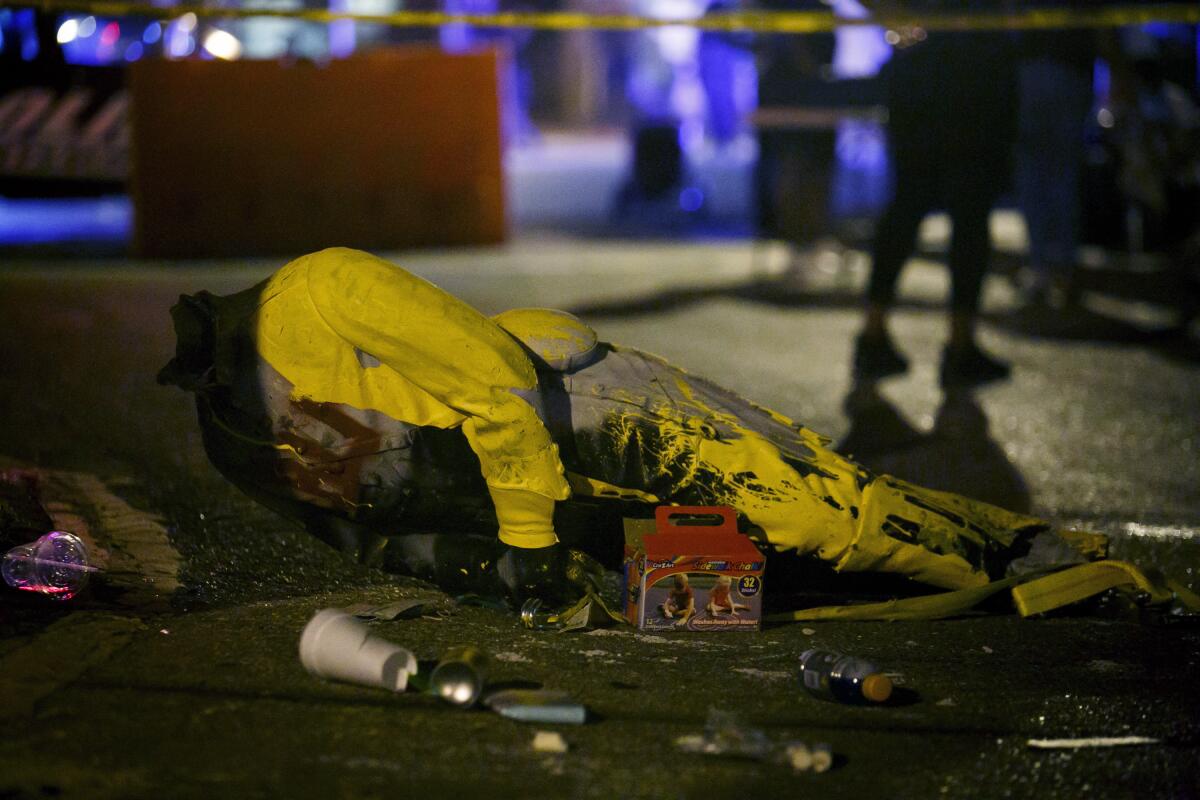
Norfolk City Council members passed a resolution expressing their desire to remove the statue after a violent white nationalist rally in Charlottesville in 2017. But a state law protecting memorials to war veterans prohibited Norfolk from doing so.
That law was rewritten earlier this year by the new Democratic majority at the General Assembly and will give localities the ability to decide what to do with monuments. Norfolk Mayor Kenny Alexander acknowledged that the new version doesn’t go into effect until July 1 but said he thinks public safety trumps waiting.
In Richmond, protesters pulled down a century-old statue of Confederate President Jefferson Davis in the former capital of the Confederacy.
The 8-foot bronze figure on Richmond’s grand Monument Avenue had been all but marked for removal by city leaders in a matter of months, but demonstrators took matters into their own hands the night of June 10, tying ropes around its legs and toppling it from its stone pedestal onto the pavement.
A crowd cheered and police looked on as the monument — installed by a Confederate heritage group in 1907 — was towed away.
There were no immediate reports of any arrests.
Also in Richmond, a statue of Columbus was torn down by protesters, set on fire and then thrown into a lake.
The figure was toppled in less than two hours after protesters gathered in the city’s Byrd Park, chanting for the statue to be taken down.
After the figure was removed from its pedestal around 8:30 p.m., June 9, by protesters using several ropes, a “Columbus Represents Genocide” sign was placed on the spray-painted foundation. It was then set on fire and rolled into a lake in the park, NBC 12 reported.
In the city’s Monroe Park, protesters tore down a statue of Confederate Gen. Williams Carter Wickham on June 6.
On June 16, the Howitzers Monument near Virginia Commonwealth University’s Monroe Park campus was toppled after protesters who spent the night marching in the rain used a rope to pull it down from its pedestal. The monument depicted a Confederate artilleryman standing in front of a gun.
In Farmville, a small town southeast of Richmond, council members voted unanimously to remove a statue of a Confederate soldier, the Farmville Herald reported. A crane arrived to take down the monument almost immediately after the conclusion of the council meeting. Officials said in a statement they were concerned about safety issues and property damage, and the statue will be stored in an off-site location.
— Associated Press and Times staff writer Georgia Geen
This post was compiled by Georgia Geen
More to Read
Sign up for Essential California
The most important California stories and recommendations in your inbox every morning.
You may occasionally receive promotional content from the Los Angeles Times.
